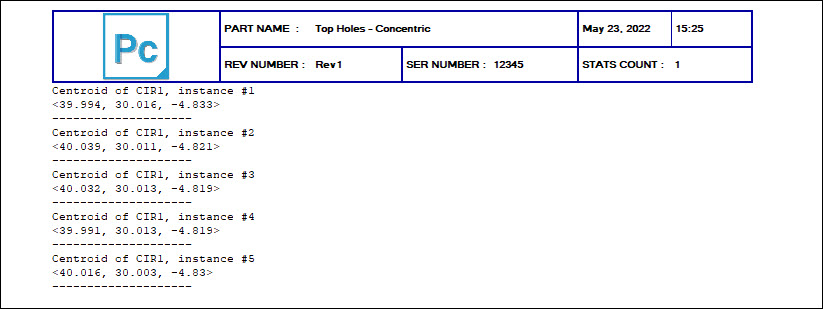Feature Arrays
When a feature is measured more than once during routine
execution because of some kind of loop, the software creates a feature
array automatically. The number of elements in the feature array is equal
to the number of times that the feature has been executed.
If a measured circle feature is inside a while
loop that executes five times, then an array of five measured circles
exists. If the id of the measured circle is CIR1, then you can use
an array expression to access individual instances of the measured
circle object. You use square brackets to indicate the instance you
want, like this:
ASSIGN/V1=CIR1[3].X
V1 is assigned the measured X value of the third
instance of the CIR1 circle.
When a feature array exists for a given feature, but array
notation is not used in a reference to that feature, the most recent instance
is used. From the above example, the reference CIR1.X
would be the same as CIR1[5].X, since
the fifth instance would be the most recent instance of the object.
You can use expressions within the square brackets
of an array expression:
CIR1[3].X
and CIR1[2+1].X
would therefore be equivalent.
This next example uses two While / End While loop command
blocks. The first block executes the CIR1 circle five times. The second
block uses the V1 variable inside of square brackets, like this, CIR1[V1].XYZ, to send the measured centroid
of each of the five executions to the Report window:
ASSIGN/V1=1
WHILE/V1<6
CIR1 =FEAT/CIRCLE,CARTESIAN,IN,LEAST_SQR
THEO/<40,30,-4.824>,<0,0,1>,30
ACTL/<40.002,29.991,-4.836>,<0,0,1>,29.982
MEAS/CIRCLE,4,ZPLUS
HIT/BASIC,NORMAL,<41.984,44.868,-2.885>,<-0.132272,-0.9912135,0>,<41.972,44.85,-2.891>,USE THEO=YES
HIT/BASIC,NORMAL,<51.721,39.36,-5.094>,<-0.781412,-0.6240155,0>,<51.706,39.375,-5.107>,USE THEO=YES
HIT/BASIC,NORMAL,<54.792,32.491,-5.44>,<-0.9861119,-0.1660821,0>,<54.775,32.474,-5.453>,USE THEO=YES
HIT/BASIC,NORMAL,<52.526,21.748,-5.879>,<-0.8350841,0.5501223,0>,<52.537,21.764,-5.893>,USE THEO=YES
ENDMEAS/
ASSIGN/V1=V1+1
END_WHILE/
ASSIGN/V1=1
WHILE/V1<6
COMMENT/REPT,
"Centroid of CIR1, instance #" + V1
CIR1[V1].XYZ
COMMENT/REPT,
--------------------
ASSIGN/V1=V1+1
END_WHILE/
Here is the generated output to the Report window:

Arrays also exist on dimensions and alignments that
have been executed multiple times in a given execution run. Thus, Dim1[2].Nom
and Align1[4].Origin
would be available given that the Dimension "Dim1" has executed
at least twice and the alignment "Align1" has executed at least
four times.
If a feature array reference is out of bounds (for
example, the user asks for CIR1[2.5]
or CIR1["Hello, World"])
the upper or lower bound item is returned. If Circle1 had 3 instances
then CIR1[4] and above would return
the value for CIR1[3], and CIR1[0]
and below would return the value for CIR1[1].
All expressions between square brackets are coerced to integer, thus 2.5
would become 2 and "Hello World" would become 0.
